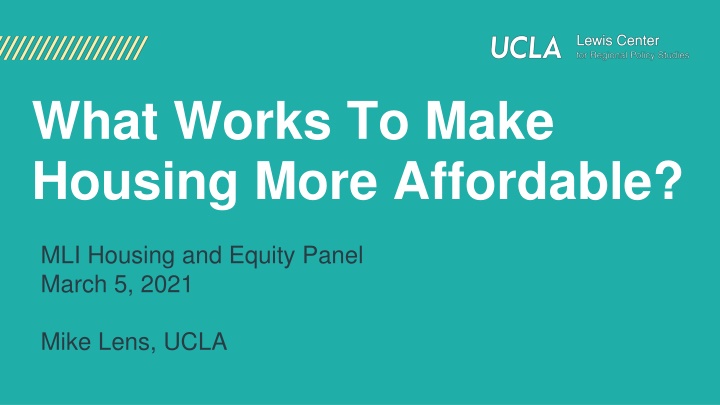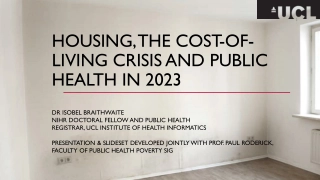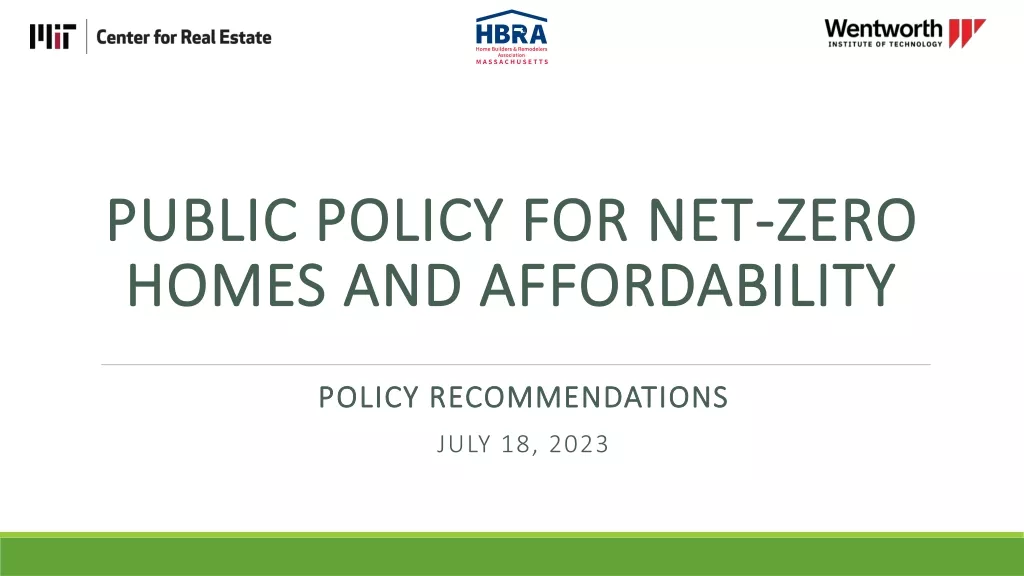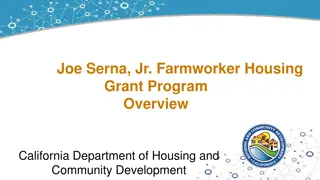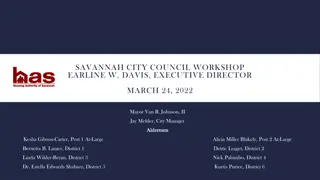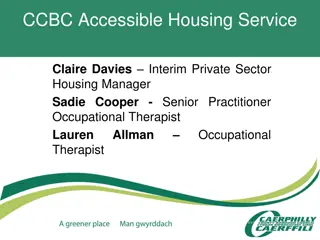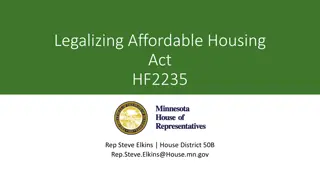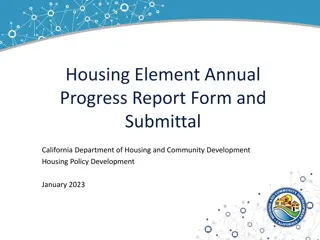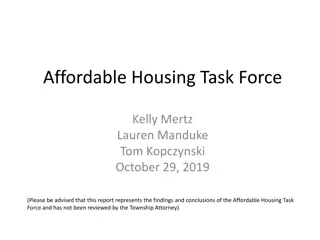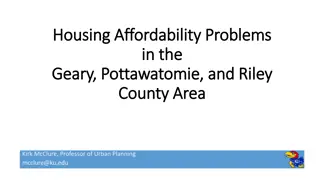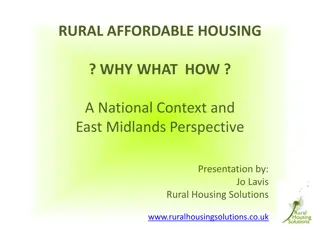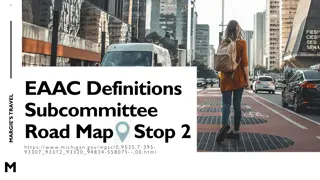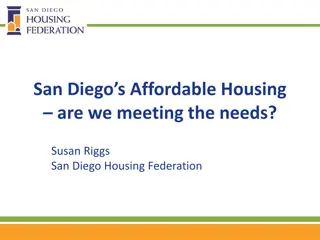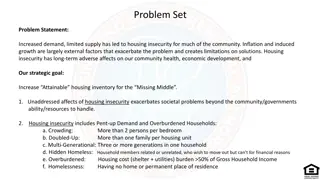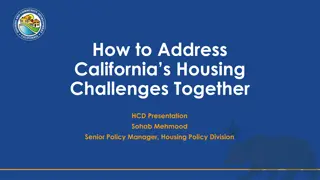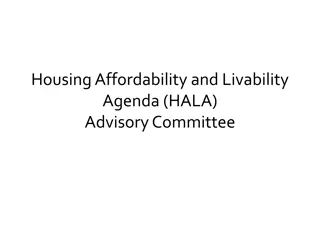Addressing Housing Affordability Challenges in California
California faces significant challenges with housing affordability impacting issues like homelessness, segregation, and gentrification. Learn about the root causes and persistent patterns that contribute to these disparities.
Download Presentation

Please find below an Image/Link to download the presentation.
The content on the website is provided AS IS for your information and personal use only. It may not be sold, licensed, or shared on other websites without obtaining consent from the author.If you encounter any issues during the download, it is possible that the publisher has removed the file from their server.
You are allowed to download the files provided on this website for personal or commercial use, subject to the condition that they are used lawfully. All files are the property of their respective owners.
The content on the website is provided AS IS for your information and personal use only. It may not be sold, licensed, or shared on other websites without obtaining consent from the author.
E N D
Presentation Transcript
What Works To Make Housing More Affordable? MLI Housing and Equity Panel March 5, 2021 Mike Lens, UCLA
California has a huge housing affordability problem that causes and interacts with: Homelessness Segregation Gentrification and displacement COVID-19 makes all of this worse
Homelessness America has more than half a million homeless people, and nearly 1 in 4 live in California Black people make up 9 percent of the LA County population, and 40 percent of its homeless population
Gentrification: MUCH bigger problem in California Most low-income people in US live in areas where the low-income population is concentrating, not being pushed out. BUT California is different. Cities where more than 10 percent of the population lives in areas that have undergone strong low-income displacement: Atlanta, Austin, Baltimore, Boston, Denver, Hartford, Houston, Long Beach, Los Angeles, New Orleans, New York City, Norfolk, Oakland, Philadelphia, Portland, Providence, Saint Louis, San Diego, San Francisco, Santa Ana, Seattle, Virginia Beach, and Washington, D.C. By some measures, LA has the nation s worst displacement Black exodus: LA County lost over 120,000 Black residents from 1980 to 2014. 6
Segregation Over 70 percent of Black Americans who live in today s poorest neighborhoods are from the same families that lived in the poorest neighborhoods of the 1970s. 66% of Black children born 1985-2000 grew up in neighborhoods with poverty rates > 20%, compared to 6% of White children.
Why do these segregation patterns persist? Overt discrimination is less common than it used to be, but still plays a role Homeseekers of various races and ethnicities have pejorative perceptions of Black spaces and neighborhoods, and avoid them As a result, the market devalues Black neighborhoods Income and wealth disparities persist, making it more difficult for Black households to afford White neighborhoods We make it incredibly easy for people to exclude some housing types and, by extension, the people who would live in them.
Exclusionary Zoning Land use regulations come in many forms, for many reasons (good, bad, unintended consequences) But many land use regulations have exclusionary intent: once racial covenants, redlining, etc. no longer ok, land use regulations increasingly utilized to segregate people. The simplest versions are minimum lot sizes, parking requirements, floor-to- area ratios, single-family zoning. 9
Build more housing in higher opportunity neighborhoods
There are roughly three things we can do about housing affordability Build more (supply) Longer run effect on housing affordability Most processes controlled locally Give people money (subsidies) More resources at federal level Price controls and other renter protections Short-term, immediate effects These complement one another, no one option is sufficient 11
Banning multi-family housing often bans people of color Lots of research (Pendall 2000; Massey and Rothwell 2009; Quigley et al 2004; Rothstein 2017; Trounstine 2018) finds tighter land use restrictions exacerbate segregation by race. Same (Pendall 2000; Rothwell and Massey 2010; Lens and Monkkonen 2016) for segregation by income.
Black households are less likely to own their own homes or live in single-family homes American Community Survey 5-year data, 2014-2018
What do we do? Build more housing in higher opportunity neighborhoods. How? Legalize midsized multifamily housing in more places, especially in single-family home neighborhoods with higher opportunity. Implement an aggressive Fair Housing strategy housing developers do want to build in higher income/whiter neighborhoods. Local residents are empowered to stop it.
Zoning reform is necessary, insufficient on its own Also need more generous subsidies and renter protections, but zoning reform is highly complementary to these polices: Subsidy dollars go farther both for vouchers and new construction of below market-rate units. Renter protections need to be stronger when engaging in upzoning but support for tenant protections should not be a reason not to allow more housing in more places.
THANK YOU! Mike Lens mlens@ucla.edu Associate Professor of Urban Planning and Public Policy Associate Faculty Director Lewis Center for Regional Policy Studies UCLA Luskin School of Public Affairs 18
